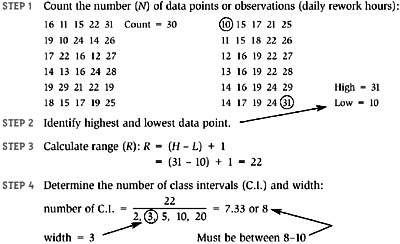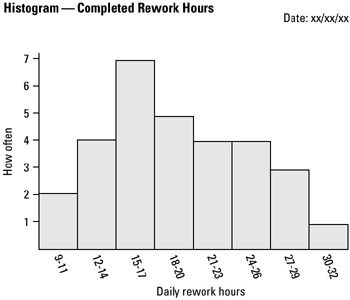Tool 90: Histogram
| AKA | Histogram Analysis |
| Classification | Analyzing/Trending (AT) |
Tool description
A histogram is a column graph that displays the central tendency, process variability and relative frequency of collected data. Typically taken from a frequency distribution, a histogram is very effective in providing a visual presentation of how actual measurements of characteristics vary around a target or specification value.
Typical application
-
To show problematic process variations from a desired result or value.
-
To determine if the process variablity within a data distribution is within specification limits.
-
To identify shifts in process capability.
-
To verify changes in the process after improvements have been made.
Problem-solving phase
| → | Select and define problem or opportunity |
| → | Identify and analyze causes or potential change |
| Develop and plan possible solutions or change | |
| → | Implement and evaluate solution or change |
| → | Measure and report solution or change results |
| Recognize and reward team efforts |
Typically used by
| 1 | Research/statistics |
| Creativity/innovation | |
| Engineering | |
| 2 | Project management |
| 4 | Manufacturing |
| 5 | Marketing/sales |
| Administration/documentation | |
| Servicing/support | |
| 3 | Customer/quality metrics |
| Change management |
before
-
Checksheet
-
Frequency Distribution (FD)
-
Events log
-
Observation
-
Box Plot
after
-
Pareto chart
-
Multivariable Chart
-
Presentation
-
Pie Chart
-
Stratification
Notes and key points
-
Preparation for grouping:
-
Determine the range (R) of the distribution

-
For small data sets (N < 100): Number the class intervals (C.I.) between 5-10, if (N > 100): Number the class intervals (C.I.) between 10-20.
-
Width of C.I. to be 2, 3, 5, 10, 20, for smaller samples, add zeros for larger data sets.
-
Select number of class intervals by calculating:

-
Check to determine if lowest data point in the data set is divisible an equal number of times by the C.I. width. if not, select the next lowest data point that is equally divisible.
Step-by-step procedure

-
STEP 5 List resulting Class Intervals (C.I.) and frequency (f):
C.I.
f
9–11
2
12–14
4
15–17
7
18–20
5
21–23
4
24–26
4
27–29
3
30–32
1
-
STEP 6 Construct a histogram. Apply the 3:4 ratio rule: The height of the Y axis must be 75 percent of the length (100 percent) of the X axis.
-
STEP 7 Complete the histogram to display the number of rework hours completed during the last 30 days. Date the histogram.
Example of tool application

EAN: 2147483647
Pages: 326